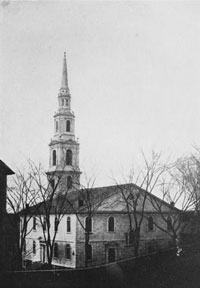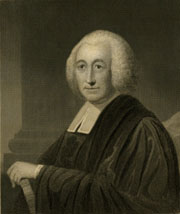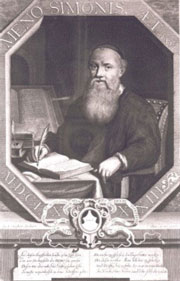Small Planet Communications, Inc. + 15 Union Street, Lawrence, MA 01840 + (978) 794-2201 + Contact








Tourists can visit the First Baptist
Church in America in Providence,
Rhode Island.
Baptists
The forerunners of present-day Baptists were the Anabaptists of the Reformation period. Some Anabaptist congregations were formed in Holland in the early 17th century when groups of Puritan Independents, or Congregationalists, fled from England to Holland. Returning to England, this group formed the first Baptist congregation in 1611. In 1638, Roger Williams founded the first Baptist church in America in Providence, Rhode Island.
Catholicism
Maryland, which was chartered in 1632 and formally settled in 1634, was intended by its proprietors to be a refuge for persecuted English Catholics. George Calvert and his son, Cecilius, the first and second Lord Baltimore, offered Catholics land grants in the new colony.
Comparatively few Catholics accepted their offer, and they were a minority in Maryland's population from the beginning. Catholics were often the targets of social resentment and distrust. In 1649, Cecilius Calvert feared for their future and approved the Act of Toleration. The growing number of New England Puritans, with strong support from Puritans in England, repealed the Act in 1654.
However, Maryland's Catholics were too well established to be exiled. The colony remained a center of American Catholicism, and in 1808 the first bishop appointed in the United States was seated in Baltimore.
Huguenots
Who were the Huguenots? Learn
more about their origins, creed
and institutions, and history.
The name Huguenot describes French Protestants of the 16th and 17th centuries. In its early stages, French Protestantism was largely inspired by Martin Luther during the European Reformation. Through the initial ambivalence of the French crown and the enthusiastic activities of preachers, Protestantism spread rapidly. The movement's leadership was increasingly taken over by John Calvin, who sent teams of missionary preachers from Geneva into France.
With the onset of the French Wars of Religion in 1562, the Huguenots emerged not only as a religious movement but also as a highly organized military force. The wars greatly reduced their numbers, however, and the bloodshed on both sides culminated in the Saint Bartholomew's Day Massacre on Aug. 24, 1572, when thousands of French Protestants were killed. The wars subsided after King Henry IV, who had come to the throne in 1589, nominally converted from Protestantism to Roman Catholicism and issued the Edict of Nantes in 1598, creating a cease-fire and a state of partial religious toleration.
In 1685 the Edict of Nantes was revoked, and thousands of Protestants decided to emigrate from France rather than accept Catholicism. Some went to countries such as Holland, Germany, England, and Switzerland. Others crossed the Atlantic to settle mainly in the colonies of Massachusetts, New York, South Carolina, Pennsylvania, and Virginia. The Huguenots adapted easily to life in America. As their numbers continued to grow, they spread into other areas.
Judaism
The Jews trace their descent from the biblical Israelites. They are not a race; Jewish identity is a mixture of ethnic, national, and religious elements. The word Jew is derived from the kingdom of Judah, one of the twelve tribes of Israel. In the Bible, foreign people used Hebrew as a name for the Israelites; today it is applied only to the Hebrew language.
From the start, their claim to be God's chosen people, their refusal to worship other gods, and their insistence on special religious laws placed Jews in a difficult position. Religious persecution was common in Europe, inspired by competition from the growing Christian merchant class and by zealous churchmen.
Read about the arrival of the
first Jews in New Amsterdam,
as well as Asser Levy who eventually
became a successful businessman.
The first Jews settled in colonial America around 1654, when 23 Brazilian Jews relocated to New Amsterdam (present-day New York). Governor Peter Stuyvesant refused to accept them until the Dutch West India Company forced Stuyvesant to oblige. Small numbers of Jews continued to come to the British North American colonies during the last half of the 17th century, settling mainly in seaport towns such as Newport, Rhode Island. Today, more than 6 millions Jews live in the United States.
Lutheranism

Learn about Henry Melchior
Muhlenberg, who brought
Lutheranism to America.
A Lutheran is a Christian who follows the teachings of German reformist Martin Luther. In 1517, Martin Luther, an Augustinian monk, declared a challenge to the church on 95 theological issues. Luther hoped that the Catholic Church would reform its teachings and practices, specifically the abuse of indulgences. His actions sparked a monumental debate, after which he and his followers separated from the church.
Lutheranism arrived in America with the early European settlers around 1624. Dutch, German, and Scandinavian Lutherans settled in New Amsterdam (present-day New York). In 1637, the Swedes founded another Lutheran settlement in present-day Wilmington, Delaware. By the middle of the 18th century, nearly 30,000 German Lutherans had settled in eastern Pennsylvania. In 1748, German Pastor Henry Melchior Muhlenberg founded the first Lutheran synod in North America.
Mennonites

Biography of Menno Simons,
the founder of the Mennonites.
The Mennonites, a Protestant religious group descended from the 16th-century Anabaptists, take their name from Menno Simons, a Dutch Roman Catholic priest converted to the Anabaptist faith, whose moderate leadership restored balance to the movement.
The Mennonites rejected infant baptism, the swearing of oaths, military service, and worldliness. They practiced strict church discipline in their congregations and lived simple, honest lives in emulation of the earliest Christians. Because of their seemingly radical beliefs, the Mennonites were persecuted. These persecutions led to the emigration of Mennonite groups to the American colonies in 1683, where they settled in Germantown, Pennsylvania.
In 1693, the Amish Church broke away from the Mennonites. Named for Jacob Ammann, a 17th-century Swiss Mennonite bishop, the Amish chose a more conservative, simple way of life. Old Order Amish avoid modern technology in farming and transportation, wear plain clothing, live without electricity, and continue to speak a German-English amalgam (Pennsylvania Dutch).
Methodism
Read more about John Wesley
and Methodists at
The Museum of Methodism.
Read a biography of George
Whitefield.
The Methodist movement was led by John Wesley, his brother Charles, and George Whitefield in 18th century England. The name Methodist comes from the resolution of its members to conduct their lives and religious study by rule and method. Ordained ministers with the Church of England, the Wesley brothers were largely influenced by the beliefs of the Moravians. The brothers soon began preaching their Methodist doctrine in barns, houses, and open fields—wherever large audiences could gather. The Wesleys traveled throughout England, Scotland, Wales, and Ireland, preaching to large, enthusiastic crowds.
John and Charles Wesley came to America in 1736 as spiritual advisers to James Oglethorpe, founder of the Georgia colony. There, they preached Wesleyan Methodism to colonists as well as Native Americans before returning to Europe. In 1741, George Whitefield broke with John Wesley and started his own branch of Calvinist Methodism. Whitefield led several preaching tours throughout the colonies and became an influential figure in the Great Awakening.
By 1784 the spread of the Methodist movement, especially in America, made an organization separate from the Church of England necessary. Nearly 25 different branches of Methodism still exist in the United States today.
Moravians
Learn more about the Moravian
church history in America.
The Moravian Church originated in Bohemia (present-day Czech Republic) in 1457, sixty years before Martin Luther sparked the Reformation in Europe and 100 years before Elizabeth I established the Anglican Church in England. The Moravians, also known as the Unity of Brethren, are a Protestant group closely tied to Lutheranism.
By 1517, the Moravians' number had grown to nearly 200,000 members. However, the Unity was severely persecuted throughout the 16th century. The Thirty Years' War in the 17th century brought even more persecution to the Moravian Church. Finally, a spiritual renewal took place in the congregation in 1727, and the Unity of Brethren began sending missionaries to different parts of the globe—including colonial America.
Bishop Augustus Spangenberg was sent to America, where he founded a Moravian settlement in North Carolina. Other successful Moravian communities were settled in Pennsylvania, New Jersey, and Maryland.
Presbyterianism
Learn more about the history
of Presbyterianism in America.
Presbyterianism is a Protestant religion that originated in Scotland in 1592. Its organization is based on a hierarchy of courts composed of clerical and lay elders, in which presbyters, or elders, govern. Individual Presbyterian congregations elect their own elders, including the minister, who together govern the church as a session.
Popular in Scotland and England, Presbyterianism also spread to North America. Colonists gathered at Presbyterian meeting houses as early as 1640, and a Presbyterian population could be found in nearly every English colony. In 1706, Irish missionary Francis Makemie established the first presbytery in America in Philadelphia.
Puritanism
Read more about
Separatists and Puritans.
Puritans were also Calvinist Protestants within the Church of England. They believed the European Reformation had not gone far enough in reforming the doctrines and structure of the church. Puritans hoped to eliminate all Catholic influence from the national church.
The English Puritans were large in number and known for their fiery spirit. They openly demonstrated a critical attitude toward the religious compromises made during the reign of Elizabeth I. After James I became king of England in 1603, Puritan leaders had a new hope for change, and they asked King James to grant several reforms to the Protestant church. However, James rejected most of their proposals in favor of the Anglicans. In the following years, the government and the church hierarchy, especially under Archbishop William Laud, became increasingly repressive, causing many Puritans to emigrate.
Quakerism
Click to learn more about the
Quakers, also known as the
Religious Society of Friends.
The Religious Society of Friends, commonly called Quakers, originated in 17th-century England. In the 1650s, George Fox began preaching that there was "that of God in every man"—that every individual had the light of God within. Consequently, these Christians had no need of priests, ministers, and bishops, or even the need for the Bible or a common text. They relied solely on the innate goodness of the individual and the power of communal prayer.
Their views conflicted with those of other churches, and Quakers were persecuted in England for deviating so far from orthodox Christianity. In the face of imprisonment and even torture, the new movement expanded in England.
The first Quakers arrived in Colonial America in 1656. Their beliefs conflicted strongly with the Puritans of Massachusetts Bay, who persecuted, tortured, and banished the Quakers. Four were even executed for their religious beliefs. Nevertheless, small groups of Quakers established throughout New England persevered and grew, such as that on Nantucket Island.
In 1681 William Penn, a Quaker himself, founded Pennsylvania as a "holy experiment" in religious toleration. Pennsylvania grew into a successful colony, and Quakers remained a powerful force until the American Revolution.
Separatism
Separatists were a small Calvinistic group of Protestants. The Separatists felt that if they could not worship as they wished in the established church, they wanted the right to "separate" and set up their own church. This put them at odds with the Church of England, a national church to which all subjects of the crown were required to adhere. In 1620, a group of Separatists decided to move to North America. These "Pilgrims" landed at a place called Plymouth in that year.
To learn more about religion in colonial America, visit America as a Religious Refuge, a website sponsored by the Library of Congress.
Religions | Bibliography
Baptists
- Anabaptists. "Anabaptist History Mystery." Accessed 06/10/19. http://www.anabaptists.org/history/histmyst.html
- Library of Congress. "Today in History-February 5: Roger Williams, Rhode Island Founder." Accessed 06/10/19. http://lcweb2.loc.gov/ammem/today/feb05.html
Catholicism
- Archdiocese of Baltimore. "Most Rev. John Carroll." Accessed 06/10/19. https://www.archbalt.org/most-rev-john-carroll/
- Infoplease. "Maryland: History." Accessed 06/10/19. http://www.infoplease.com/encyclopedia/us/maryland-history.html
Huguenots
- Catholic Encyclopedia. "Huguenots." Accessed 06/10/19. http://www.newadvent.org/cathen/07527b.htm
- Huguenot Society of America. "Huguenot History." Accessed 06/10/19. http://huguenotsocietyofamerica.org/?page=Huguenot-History
Judaism
- Judaism 101. "Who is a Jew?" Accessed 06/10/19. http://www.jewfaq.org/whoisjew.htm
- Sephardic Genealogy Resources. "Who are the Sephardim?" Accessed 06/10/19. https://www.jewishgen.org/Sephardic/seph_who.htm#sephardim
Lutheranism
- Catholic Encyclopedia. "Lutheranism." Accessed 06/10/19. http://www.newadvent.org/cathen/09458a.htm
- Encyclopedia of World Biography. "Martin Luther." Accessed 06/10/19. http://www.encyclopedia.com/topic/Martin_Luther.aspx
- Historical Society: Trappe, Collegeville, and the Perkiomen Valley. "From the Journals of Henry Melchior Muhlenberg 1777." Accessed 06/10/19. http://trappehistoricalsociety.org/from-the-journals-of-henry-melchior-muhlenberg-1777-rev-judith-a-meier-historian/
Mennonites
- Catholic Encyclopedia. "Mennonites." Accessed 06/10/19. http://www.newadvent.org/cathen/10190b.htm
- Encyclopedia of Protestantism. "Radical Reformation." Accessed 06/10/19. http://protestantism.enacademic.com/500/Radical_Reformation
- Encyclopædia Britannica. "Beliefs and Practices: Mennonite." Accessed 06/10/19. http://www.britannica.com/EBchecked/topic/375156/Mennonite/233526/North-America#toc4815
Methodism
- Encyclopedia.com. "Methodism." Accessed 06/10/19. http://www.encyclopedia.com/topic/Methodism.aspx
- William Carey University. "John Wesley: Founder of Methodism and Missionary
to America." Accessed 06/10/19. http://www.wmcarey.edu/carey/wesley/
wesley.htm
Moravians
- Hammerwood Park. "Moravian Church." Accessed 06/10/19. http://www.hammerwood.mistral.co.uk/zinz.htm
- Moravian Church in North America. Accessed 06/10/19. http://www.moravian.org/the-moravian-church/the-moravian-church/history.html
Presbyterianism
- Encyclopedia.com. "Presbyterians." Accessed 06/10/19. http://www.encyclopedia.com/topic/Presbyterians.aspx
- The Presbytery of Southern New England. “History of the Presbytery.” Accessed 06/10/19. https://psne.org/who-we-are/
- Religion Facts. "History of Presbyterianism." Accessed 06/10/19. http://www.religionfacts.com/christianity/denominations/presbyterian/
history.htm
Puritanism
- Catholic Encyclopedia. "Nonconformists." Accessed 06/10/19. http://www.newadvent.org/cathen/11095b.htm
- American Experience. “People and Ideas: Early American Groups.” Accessed 06/10/19. https://www.pbs.org/wgbh/americanexperience/features/godinamerica-early-american-groups/
Quakerism
- Benson, Lewis. "The Message of George Fox for Today." Quaker Heritage Press. Accessed 06/10/19. http://www.qhpress.org/quakerpages/qwhp/benfox.htm
- Nantucket Historical Association. “A Brief History of Quakers on Nantucket." Accessed 06/10/19. https://nha.org/research/nantucket-history/history-topics/brief-history-of-quakers-on-nantucket/
- Yardley Friends Meeting. "Beginnings (1652-1689)." Accessed 06/10/19. http://yardleyfriendsmeeting.org/quakers/beginnings-1652-1689/
Separatism
- University of Virginia. "The Pilgrims." Accessed 06/10/19. http://xroads.virginia.edu/~CAP/puritan/purhist.html
Religions | Image Credits
- First Baptist Church | Photo by George J. Vaillancourt, 1789; The Library of Congress
- Henry Melchior Muhlenberg | Artist: C. W. Peale, J. W. Steel; Historical Society of Pennsylvania, Digital Library, Simon Gratz collection
- Menno Simons | Artist: Jacobus Burghart, 1683; The Global Anabaptist Mennonite Encyclopedia Online, courtesy of Mennonite Library and Archives.
© 2020 Small Planet Communications, Inc. + Terms/Conditions + 15 Union Street, Lawrence, MA 01840 + (978) 794-2201 + planet@smplanet.com


